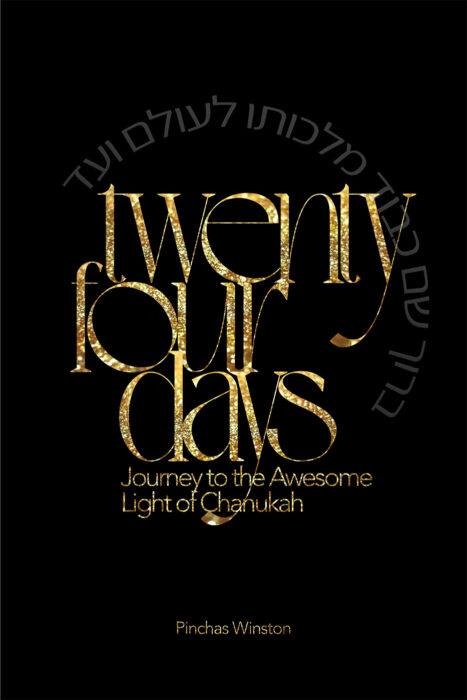Parashas Beshallach—Tu BeShevat, Issue #1083 – By Rabbi Pinchas Winstom
Friday Night
THIS SHABBOS MAKES me want to sing. (Don’t worry… you won’t hear me even if I do.) After all, it is Shabbos Shirah, the parsha with the Shir Shel Yumm—Song at the Sea. But what I’d really like to do is sing the praises of Eretz Yisroel, since this Sunday night, b’ezras Hashem, is Tu BeShevat, when we do exactly that. I can’t wait for the Seder to begin.
Seder? That’s not for another couple of months when Pesach arrives. What Seder?
The Tu BeShevat Seder, of course.
There’s a Seder on Tu BeShevat? Says who?
In the 16th century, the Arizal and his students created a Tu BeShevat seder, somewhat like the Pesach Seder, that celebrates the Aitz Chaim—the map of the sefiros. The earliest published version of this seder is called the Pri Aitz Hadar, arranged by an anonymous student of the Arizal. It is a 50-page pamphlet with instructions regarding the fruits to eat, the verses to accompany them, and the order to follow.
The Tu BeShevat Seder is a lot of fun for the novice, and probably more people do it each year. It is also extremely deep for the kabbalist, and if you want to know why, check out the sefer Tuv HaAretz: Ma’alos Peiros Eretz Yisroel. The author, Rabbi Noson Shapira, the rav of Yerushalayim during the 1600s, explains, based upon the writings of the Arizal, how different fruits of Eretz Yisroel correspond to specific sefiros in the four worlds of Asiyah, Yetzirah, Beriyah, and Atzilus, or AYB”A for short.
They’re called “worlds,” but they are more like levels of spiritual consciousness. Asiyah, which means action, is the lowest of the four worlds and the one we live in physically, and the bulk of the world’s population spiritually as well. Unfortunately, since most people relate to very little more than what they see or experience, they never tend to make it past the world of Asiyah.
Above that is Yetzirah, which means formation. It was on that level of reality that God formed physical Creation, yaish m’yaish, something from something. The materials for Creation had already been made yaish m’ayin— something from nothing—on the level of Beriyah, which means creation (from nothing). God used those “supplies” to make the physical world on the level of Yetzirah, including Gan Aiden.
The “nothing” from which God made the “something” was actually not nothing at all. It was just completely spiritual so, compared to the physical world that followed, it was if it didn’t exist, just as a soul compared to a body. This level of reality is called Atzilus, which means emanations, because the spiritual light emanates from here to create and maintain all the worlds below.
Shabbos Day
THERE ARE MANY kinds of fruit in the world, and it is interesting how they differ from one another. Some are large, some are small, some have big pits, some have small ones, some have thin skins and some are thick skinned, etc. Why? Perhaps because of the temperature of where they grow, the availability of water, etc. That is all physically true, but it turns out that there is a kabbalistic reason for this as well.
In Tuv HaAretz, the author explains which fruits of Eretz Yisroel correspond to which level of reality, Atzilus, Beriyah, Yetzirah, or Asiyah, and why this impacts their physical make-up. It has to do with another kabbalistic idea called the Klipos, which means “peels,” because they act a spiritual barrier between a person and God. Not only do they undermine holiness, but they feed off it as well to become stronger and deadlier.
Consequently, we do our best to avoid “feeding” the Klipos any more than their Divine due (evil is necessary for free will). Simply, that translates into minimizing sin, because sin feeds the Klipos the most, and. We also protect whatever kedushah—holiness—we generate from the Torah we learn and the mitzvos we do. This is why we don’t learn Torah at certain times of the year, and in places associated with spiritual impurity.
The fruits of Eretz Yisroel reflect this idea. Tuv HaAretz explains how the various fruits grow differently based upon the level of spiritual consciousness with which they are associated. The further down a fruit is in the spiritual realm, the closer it is to the Klipos and the more protection it needs, something represented by its physical reality.
There is more. Fruit (the pronunciation of the Hebrew peiros if you read the word without knowing the vowels), represents creative power. Adam HaRishon wasn’t just told to have family. He was told to be “fruitful,” a term that all cultures seem to have adapted to mean productive and successful. That is something the Klipos wish to inhibit if not stop altogether, and we are only as “fruitful” as we are because of God’s help.
Therefore, Tu BeShevat is also a time to thank God for the fruits of our labors, the kinds that grow on trees, and the ones that result from the efforts we make to get ahead in life. But there is one particular task we are supposed to focus on, as the Pri Tzaddik (Fruit of the Righteous) points out, alluded to by one word in the mishnah: elan—tree. Tu BeShevat is called the “Rosh Hashanah of the Tree” in the mishnah, when it should really have written “trees.”
There’s a deep reason for that.
Seudas Shlishis
WHEN YOU THINK of tree and fruit, what comes to mind? Okay, besides your favorite apple or lemon tree. Personally, I usually think about the Aitz HaDa’as Tov v’Ra, the Tree of Knowledge of Good and Evil, because it is such a central theme in my writings. This is not only because of what the Torah says happened through it, but because of what Kabbalah says has to happen with it, at least by the end of history.
What has to happen to the Aitz HaDa’as? What was supposed to have happened back in Gan Aiden, had Adam HaRishon only waited until Shabbos to eat its fruit. It would have joined together with the Aitz HaChaim, the Tree of Life, and become one with it. As the Pri Tzaddik explains, Tu BeShevat reminds us of this and celebrates our opportunity to do this. And just as the rabbis composed the Pesach Seder to help us gain personal freedom in our time, the kabbalists later composed the Tu BeShevat Seder to help us focus on our daily life task, and facilitate the tikun process.
Eating has a lot to do with it. As most of us merrily eat without giving much thought to what it is doing for the world in general, we are completing one of the most important tikun processes there are: Birrur. Birrur is separation, because that is what we’re here to do: separate the holy sparks from the impure aspects of Creation in which they are absorbed.
Just as our bodies physically separate the nutrients in food from the waste and use the good while disposing of the bad, the eating process is doing the same on a spiritual level. If a food is “healthy,” it is because of the holy sparks it contains. The “unhealthy” part is where the sparks are not (french fries taste great but they do not contain many sparks or they’d be healthy to eat).
While combined, the food (and we too!) have the status of an aitz haDa’as tov v’ra—a tree of knowledge of good and evil. Once the good is removed and the “evil” is disposed of, that thing changes its status to an aitz hachaim, a tree of life, so to speak, and Creation is that much more rectified.
The holier the foods, the more sparks they contain, and no food is holier than food that is grown in Eretz Yisroel and then used for a mitzvah. Since there is a hierarchy of fruits that correspond to the hierarchy of worlds, the Seder takes us higher and higher to each of the four levels of spiritual consciousness.
Of course, wine is one of the ultimate symbols of the tikun process, and four cups of wine are part of the Tu BeShevat Seder as well, but with a twist. Though Kiddush is usually made with red wine on all other holy occasions, for the Tu BeShevat Seder it is made on white wine, representing the snow on Mount Hermon and the cold winter season. For the second cup, one-third red wine is combined with two-thirds white wine, representing the beginning of spring.
The third cup is half white and half red, corresponding to the spring which has half rainy days and half sunny days. And the fourth cup is all red wine, symbolizing the hot summer days that end the agricultural season. Shlomo HaMelech wrote, “Do not look at wine when it is red; when he puts his eye on the cup, it goes smoothly” (Mishlei 23:31). But as Rashi explains, that is talking about the person who drinks only to get drunk. At the sederarim of Tu BeShevat and Pesach, we drink as a means to free our souls to come closer to God.
Ain Od Milvado, Part 37
As I mentioned in the previous parsha, whether you like the Erev Rav or hate them, they were, are, necessary as a means for the Jewish people to actualize potential that otherwise would have remained unrealized. All adversity is for this reason, and though we may want to question the means, the end is for certain.
Amalek too. We have to hate them. We have to go to war against them. But we also have to realize what Rav Hutner, zt”l, said in his drush on Chanukah. Doubt pushes us to intellectual and spiritual clarity, and it is that intellectual and spiritual clarity that brings us closer to God.
Amalek epitomizes doubt in God and His providence. His name equals suffek—doubt—in gematria (240). This number is also the difference in gematrios between the first and second verses of the Shema. As mentioned in previous Perceptions, the Shema represents the unwavering clarity of the angels in Heaven, and Boruch Shem represents our lower level of clarity which, at this stage of history, is more of an emumah. It’s what you get when you add “Amalek” to the clarity of the Shema.
The opposite of this is what we find in this week’s parsha, what the Jewish people said after they safely crossed the sea and the Egyptians drowned:
This is my God and I will glorify Him. (Shemos 15:2)
He revealed Himself in His glory to them, and they pointed at Him with their finger. By the sea, [even] a maidservant perceived what prophets did not perceive. (Rashi)
This is why the episode of Amalek interrupts the incredible revelation of God at Yum Suf, and the even more incredible revelation of God at Har Sinai. Amalek was not just a historical hiccup. He was a necessary crisis to push us to grow enough spiritually to be ready to receive Torah at Har Sinai. The attack in Rephidim helped push the Jewish people from theoretical of ain od Milvado to the actual ain od Milvado. This is why next week’s parsha’s connects the two events with this verse:
They journeyed from Rephidim, and they arrived in the desert of Sinai, and they encamped in the desert, and the Jewish people encamped there opposite the mountain. (Shemos 19:2)
And that is the ULTIMATE tikun on every level. Taking the knowledge of Ain Od Milvado from the level of dayah—general awareness—to Binah—intellectual understanding—and then to Haskel—intellectual and emotional integration, is why God made all of Creation in the first place, and continues to maintain it. This is THE tikun of the Aitz HaDa’as Tov v’Ra.
The drinking feast of Tu BeShevat is when we achieve the level of Dayah of this and start the process of ascending. The Purim Mishteh, we will see b”H, is the opportunity to ascend to the level of Binah. As a result, the four cups of wine on Pesach together with the rest of the Seder, can allow us to reach the ultimate level of Haskel of Ain Od Milvado. That is the true path to lasting freedom. Chag Samayach.
Rabbi Pinchas Winston
Thirtysix.org



















